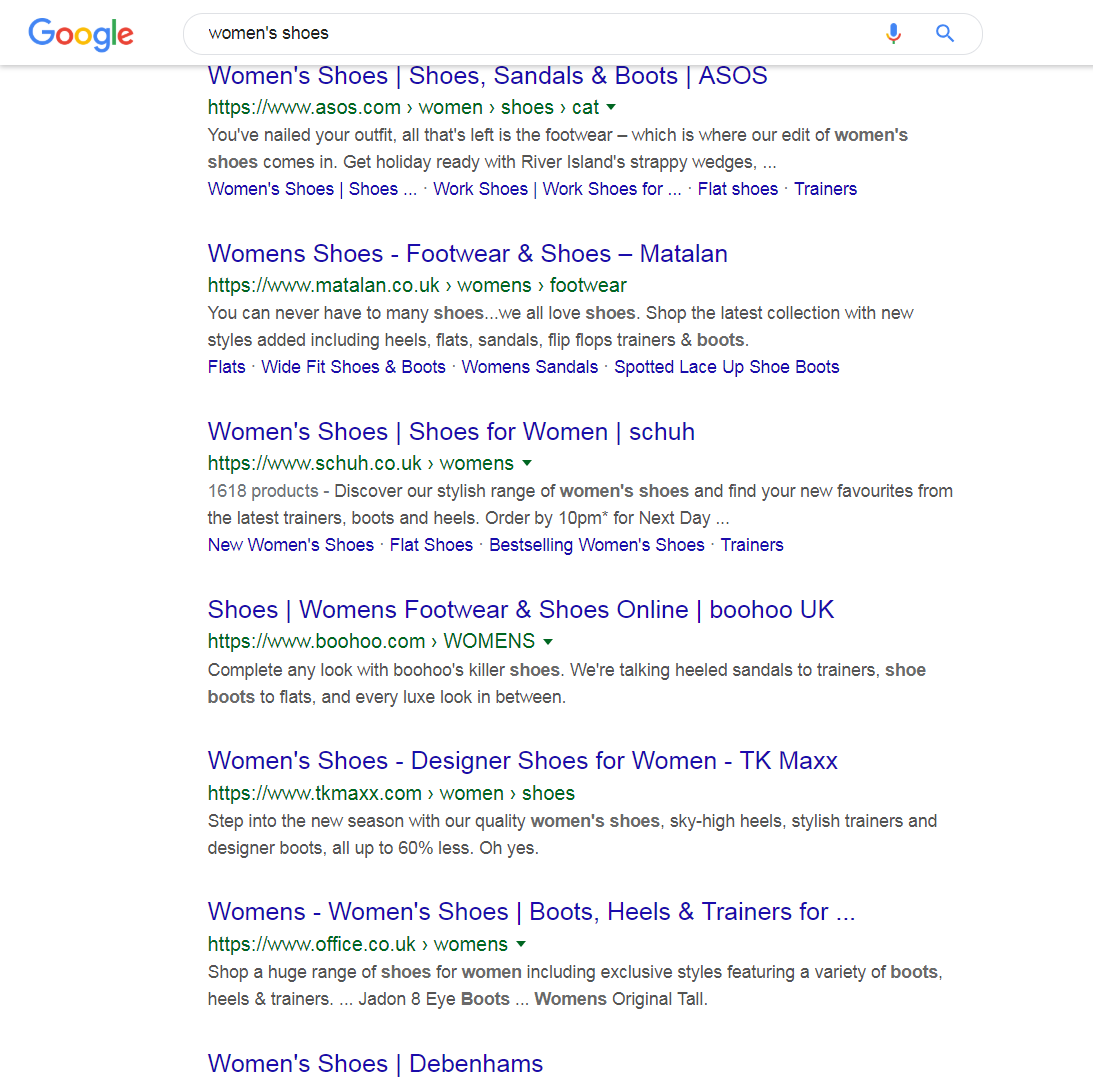One of the best ways to get traffic to your online store is by appearing in search engine rankings. This isn’t always an easy task, since ecommerce sites are focused on products rather than content. Although ecommerce SEO might be challenging, the results can pay dividends for your ecommerce business over time. In this situation, numbers don’t lie.
Consider:
- 93% of online activity begins with a search.
- 51% of all website traffic comes from organic search, compared to only 10% from paid search, 5% from social and 34% from all other sources.
- More than 40% of revenue is captured by organic traffic.
- 79% of people took a relevant action on their phone prior to making a purchase.
- 39% of purchasers were influenced by a relevant search.
You can’t always compete with the big guys, but you can focus on ranking well for individual product and category pages for less competitive terms, like long-tail keywords.
How to show up in the search rankings
Let’s look at the example of women’s shoes.

The top spots go to well-known high street brands.
The chances of you knocking out one of these big players is pretty low. But that doesn’t mean you should give up on ecommerce SEO.
In fact, you can leverage long-tail keywords — or more specific keywords and phrases — to improve your rankings and gain new customers.
For example, a search for “women’s cycling shoes” still has some big names (like Amazon). But these results aren't just limited to the big players.
Targeting less competitive terms such as this can drive traffic to your site and help you make more sales.
How to boost ecommerce search rankings in 8 steps
Successful ecommerce SEO is a little different than SEO for a content-based website. You’ll likely have more pages to optimize with less content to leverage. Plus, the threat of duplicate content is much higher. (Learn about duplicate content here.)
So, how do you optimize your ecommerce site?
- Do your keyword research for product pages and category pages.
- Optimize your pages with meta titles, descriptions and H1 tags.
- Create and optimize product and category descriptions.
- Revise and redirect URLs.
- Improve images for better loading and searchability.
- Perform technical SEO.
- Add content for additional ecommerce SEO.
- Don’t forget mobile search.
Let’s get started.
1. Do keyword research for product pages and category pages
Keyword research isn’t just about brainstorming and hoping you come up with the right terms. Using something like GoDaddy's SEO tools, you can create a list of the terms that your target customers are using to find your products.
Here are some options for keyword research:
Option 1: Google Keyword Planner
You can start your keyword research using Google Keyword Planner. You’ll have to create a free Google Ads account to use the tool, but you don’t have to build any ads or add credit card information to do research.
Once inside, add a few seed keywords. These are just the keywords that you would use if you were looking for yourself.
Don’t use your brand name or company name as one of your seed keywords.
Your site will likely rank well for your own brand name just based on how often you use it in describing your company.
From the seed keywords you entered, Google will give you more related keywords along with rough search volume. You’ll want to pick keywords that appeal to your target audience and show the right search intent.
Search intent is simply the reason people are doing the search. Are they searching to learn, to be entertained or to buy?
One good way to determine search intent is to search for the term using an incognito or private browsing window. Looking at the first few search results will give you a good idea if they are focused on purchasing or merely browsing.
Another way to determine search intent is the cost-per-click. A higher cost-per-click often indicates a purchase search intent because the companies that are paying for those clicks are willing to pay more for the likelihood of ROI.
Google search engine results pages are another great source for new related keywords. At the bottom of each page are searches related to your original term.

Option 2: Amazon predictive search
Amazon, the world’s most powerful ecommerce search platform, can help you find keywords for your own site optimization. Start by typing in your key search phrase, and Amazon’s predictive search will show you popular phrases related to your entered keyword.
The Amazon Keyword Tool can also help speed up this process.
Option 3: Paid SEO tools
Tools like Ahrefs give you powerful, in-depth tools to do keyword research, including which keywords your competitors are using. While it’s a paid tool, it can save you a great deal of time and give you powerful insights.
No matter which option you choose for your ecommerce SEO research, don’t stop with a short list of keywords. You’ll need to optimize each page — including product pages and category pages — with a unique keyword.
This is most easily accomplished by creating a spreadsheet with all of your pages, adding columns for the keyword you’re targeting on the page. If you like, you can also use the spreadsheet to create meta titles, descriptions and H1 tags. (You can download a sample spreadsheet from my Resource Library.)
- Update your meta titles, descriptions and H1 tags
Now that you’ve done your keyword research, it’s time to start putting it to work on your website. The first step is to optimize your product and category pages with meta titles, meta descriptions and H1 title tags. Each of these elements should contain your target keyword at least once.
Remember to write every element of your website for the reader, not just for search engines.
3. Create or optimize product and category descriptions
Your product and category descriptions help both your potential customers and search engines understand what you’re selling and why your products are unique.
On your category pages, you’ll only need a paragraph or two to share about your products or services. Be sure to use your target keyword in your category description.
Your product pages should have more content to help communicate the value, features and benefits of your product and help the customer make the right choice.
Your product page should include:
- A unique 150- to 200-word (or more) description of the product
- Three optimized imagesof the product — including one of the product in use, if applicable
- Customer reviews
- Product-specific details that can be easily scanned by users, such as measurements, weight, requirements, etc.
- If possible, a video of the product in use, describing why it’s better than a competitive set of products
4. URL optimization
Friendly URLs aren’t just better for sharing, they’re also important to successful ecommerce SEO.
Google prefers short, easy-to-read URLs. If possible limit your product page URLs to just your product title, without the category slug.
- Ideal: https://www.example.com/product-keyword
- Acceptable: https://www.example.com/category/product-keyword
- Avoid: https://www.example/category/category-keyword/product/product-keyword
Your ecommerce platform might dictate the choices you have for URL structures.
Before you change your URL structures, make sure you track any previous URLs and use 301 redirects to point to your new URLs.
Some ecommerce platforms will handle this automatically, so be sure to check your help site or customer support to find out what you need in order to ensure your redirects go into place.
5. Image optimization
Images are key to a successful ecommerce site, but without proper optimization, they can also hurt your ecommerce SEO.
You’ll need to find a balance between small file size and acceptable image quality in order to optimize your images.
In most cases, you should use JPEGs for images that have a lot of colour, and PNG for simple images. Test several different formats and compressions to find the right mix for the images your site uses.
Be sure to include ALT tags for all of your optimized images as well. ALT tags are used by screen readers to help visually impaired users navigate and use your site as well as by search engines to understand what your images are of.
6. Perform technical SEO steps
Good ecommerce SEO goes beyond just measuring what content is on your site and in your meta data. There are also technical elements that can contribute to your site rankings.
Improve site load times
Bounce rates increase by 50% if your website takes two extra seconds to load, and conversion rates fall by 12% for every extra second that it takes your website to load. Optimizing your images and removing unnecessary elements improves your search engine ranking and conversion rates.
Create and submit a sitemap to Google and Bing Webmaster Tools
By submitting your sitemap to Google Webmaster Tools and Bing Webmaster Tools, you’re proactively letting the two largest search engines in the world know about your site. Plus, these tools can alert you to critical issues that Google or Bing encounter with your sites.
Have a valid SSL certificate
An SSL certificate is not just something you need in your shopping cart. Since you might be collecting email addresses on other pages (with things like your email signup form), an SSL protects that data as well.
Most browsers now point out to visitors when a site isn’t secure — sometimes even directing them away. Your website host often can help you with an SSL certificate.
If you use GoDaddy's Online Store, you'll get an SSL certificate as part of your package.
Alternatively, you can buy SSL certificates here.
Make it easy to navigate
Give customers multiple ways to navigate your site — from the top navigation, to subcategories and site search. Search engine spiders use your site navigation to ensure they’re finding all of the pages on your site — making them findable to search engine users!
Add breadcrumbs to your site layout
Speaking of navigation, there’s another form of navigation that’s often overlooked that can impact your ecommerce SEO and site usability. Breadcrumbs help both your users and search engines understand how your pages relate to each other. Breadcrumb navigation is often a feature of your shop theme.
Clean up broken links
Nobody likes reaching a 404 page, including search engines. To improve your ecommerce SEO, clean up broken links by redirecting as many as you can to appropriate replacement pages.
You can find broken links using a plugin, such as Broken Link Checker for WordPress, Google Search Console, or a third-party tool like Dead Link Checker.
You also can create a custom 404 page for your site that helps point people in the right direction when they do encounter a broken link.
You can learn more about 404 page not found and how to fix it in this guide.
7. Add content to for improved searchability
Most ecommerce sites don’t feature a lot of content, which makes it hard for them to get good SEO ranking. You can change that by simply adding content with SEO in mind, that’s also useful for your customers, such as:
- Infographics
- Buyer’s guides
- Gift guides
- Comparisons
- How-to and learn-to guides
- Commonly asked questions
- Testimonials
Another type of content that you need to add to your website is reviews. Customer reviews provide more content to benefit your ecommerce SEO including giving your pages the opportunity to rank for related long-tail terms, including combinations of “Product Name Review.”
Valid customer reviews also describe your products in the terms customers use — not your marketing description — giving you even more terms that you might rank for over time.
Finally, reviews help differentiate your products from others who are offering the same or similar products and services.
8. Don’t forget mobile search
With all the talk of how to design your site for conversions and search, it’s easy to overlook the importance of mobile accessibility. But it’s hard to ignore the fact that many of us turn to our mobile devices often when we’re searching:
- 88% of userssearch on a smartphone.
- 65% of peopleuse their phone in their “I want to buy” moments.
- 40% of ecommerce salesduring the 2018 holiday season came from a smartphone.
- 13% of global ecommerce visitorsvisited from a mobile phone .
Optimizing your site for mobile search uses all of the same techniques we’ve already discussed, layered with additional testing and optimization.
- Ensure your site renders well on mobile devices.Have you ever visited a website that was riddled with pop-ups and overlays that were hard to navigate around or even impossible on your mobile phone?
- Double and triple check your load time optimizations.As internet consumers, we want everything fast-faster-fastest. The days of being willing to wait 30 minutes for a single song to download are over. Now, if a site doesn’t load — especially on our smartphones — within seconds, we’re hitting the back button to go back to our search results. Ecommerce sites often have many images that strain mobile bandwidth if not optimized properly.
- Make anchors a priority.Using anchors on your pages to link to important information, like reviews and feature lists, makes your site easier to navigate on mobile.
Unique challenges to ecommerce SEO
Ecommerce websites face additional unique challenges that most content-based websites don’t face, including:
Duplicate content
This usually happens when there are multiple variations of a product, and when a user selects a different variation, the CMS appends a variable to the URL, making it a unique page. When this happens all the content is the same on all variations, except for the name of the variation. For example:
- https://www.example.com/category1/product
- https://www.example.com/category1/product?gold
Unless the product is fundamentally different to the extent that new content can be written for the variation, the URL should stay the same when a user switches between variations.
Another option would be to canonicalize all variations to the primary default product page.
Faceted navigation
Faceted navigation refers to filters placed upon sets of products. These are common with large product sets, where the website allows users to narrow their result set by selecting additional defining product features, such as narrowing results to only products that have more than 4 stars or are available in a specific size.
The challenge is that if your filters are crawlable by the search engines (which most are), it creates almost an unlimited number of pages and product variations that litter your website with duplicate content and spammy pages. This can cause search engines to get caught in a web of infinite possibilities and waste crawl equity on low-value pages.
The good news is that there are ways to structure your filters/faceted navigation in a way that is beneficial to users and search engines.
Moz has tips on how to deal with faceted navigation if you’re a large ecommerce site.
Putting a product in multiple categories
At face value, this problem is not a concern with most content management systems. In fact, it’s often helpful to have products in multiple categories to help users find what they’re looking for.
Where websites get in trouble is when putting a product in a new category adds the category to the URL, resulting in multiple URLs for the same product. For example:
- https://www.example.com/category1/product
- https://www.example.com/category2/product
You can combat that by updating your standard URLs so that the category isn’t part of the URL. In some ecommerce management systems, you can define a primary category used in the URL while all other category URLs are secondary to that one.
Is ecommerce SEO worth it?
Improving ecommerce SEO has many moving pieces, but isn’t without its rewards. With more than 5.6 billion searches per day — that’s 63,000 searches per second on any given day, according to Search Engine Land — investing in ecommerce SEO can help you grow your business and reach.
This article includes content originally published on the GoDaddy blog by the following authors: Bill Ross, Bob Dunn and Ashley Grant.





